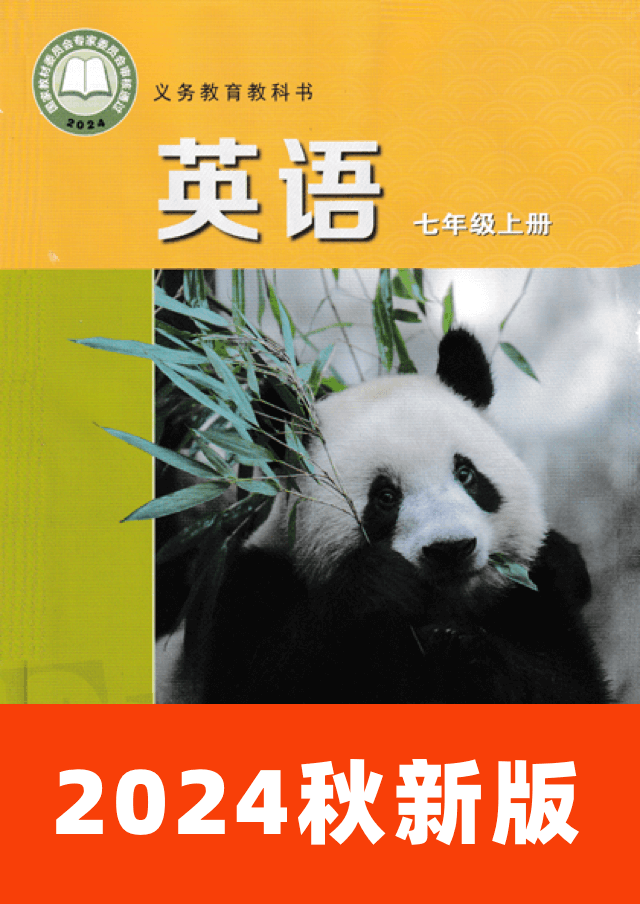Unit 5 Animal friends课文原文、中英文对照及听力音频听读
Unit 5 Animal friends 翻译:第五单元 动物朋友们
Towards the end of this unit study, you will be able to: 翻译:在本单元学习结束时,你将能够:
describe different animals; 翻译:描述不同的动物;
understand why animals are important to the world; 翻译:了解动物对世界的重要性;
explore ways to help care for and save animals. 翻译:探索关爱和拯救动物的方法。
An animal's eyes have the power to speak a great language. — Martin Buber 翻译:动物的眼睛有种神奇的力量,诉说着千言万语。 —马丁·布伯
Lesson 1 I'd like to have a pet! 翻译:第1课 我想养一只宠物!
What pets would you like to have? 翻译:你想养什么宠物?
Tick your answers. 翻译:勾选出你的答案。
cat 翻译:猫
dog 翻译:狗
fish 翻译:鱼
bird 翻译:鸟
rabbit 翻译:兔子
Other: 翻译:其他:
Listen to the conversation and answer the questions. 翻译:听对话并回答问题。
Danny is at Jenny's home. 翻译:丹尼在詹妮家。
Look, Jenny! 翻译:看,詹妮!
A little tiger is jumping off the sofa! 翻译:一只小老虎从沙发上跳下来了!
That's my new friend, Zoe. 翻译:这是我的新朋友,佐伊。
She is my aunt's cat. 翻译:她是我姨妈家的猫。
My aunt is on a business trip. 翻译:我姨妈出差了。
I'm looking after Zoe for a week. 翻译:我要照顾佐伊一个星期。
Hello, Zoe. 翻译:哈喽,佐伊。
Come here! 翻译:过来!
I have some donuts for you. 翻译:我给你带了些甜甜圈。
Danny! 翻译:丹尼!
Zoe likes cat food. 翻译:佐伊喜欢吃猫粮。
She doesn't like donuts. 翻译:她不喜欢甜甜圈。
What a pity! 翻译:真遗憾!
She's lovely and quiet. 翻译:她可爱又安静!
I'd like to have a pet, too. 翻译:我也想养只宠物。
What pet would you like to have? 翻译:你想养什么宠物?
I'd like to have a dog. 翻译:我想养条狗。
Dogs are friendly and loyal. 翻译:狗又友好又忠诚。
Yeah. 翻译:是啊。
They even help people sometimes. 翻译:他们有时还会帮助别人。
Who is Zoe? 翻译:佐伊是谁?
What does Danny think of dogs? 翻译:丹尼对狗有何看法?
What's your opinion about keeping a pet? 翻译:你对养宠物有什么看法?
Unit 5 翻译:第五单元
Listen to the conversation again and fill in the blanks. 翻译:再听一遍对话,然后填空。
Danny is at Jenny's home. 翻译:丹尼在詹妮家。
He sees a cat, Zoe. 翻译:他看到了一只猫,佐伊。
Jenny's aunt is on a business trip and Jenny is looking after her cat. 翻译:詹妮的姨妈正在出差,詹妮在照看她的猫。
Zoe is lovely and quiet. 翻译:佐伊可爱又安静。
Danny would like to have a pet dog. 翻译:丹尼想养一只宠物狗。
Dogs are friendly, loyal and even helpful. 翻译:因为狗又友好又忠诚,还乐于助人。
Listen to the dialogue and write true (T) or false (F). 翻译:听对话,判断正误,正确的写(T),错误的写(F)。
Li Ming and Wang Mei are talking about pets. 翻译:李明和王梅在聊宠物。
Wang Mei would like to have a cat. 翻译:王梅想养一只猫。
Li Ming doesn't like cats. 翻译:李明不喜欢猫。
Li Ming likes to play with his cousin's dog. 翻译:李明喜欢和表弟家的狗玩。
Work in groups. 翻译:小组合作。
Interview your classmates and complete the table. 翻译:采访同学并完成表格。
What pet would you like to have? 翻译:你想养什么宠物?
I'd like to have... 翻译:我想养……
Why do you want one? 翻译:你为什么想养?
Because they're lovely/cute/helpful/friendly/loyal... 翻译:因为他们可爱/可爱/乐于助人/友好/忠诚......
Name 翻译:名称
Pet 翻译:宠物
Reason(s) 翻译:原因
What's the most popular pet in your group? 翻译:你们小组中最受欢迎的宠物是什么?
Listen and repeat. 翻译:边听边跟读,
Write more words in each group. 翻译:在每组中写出更多单词。
/f/ 翻译:/f/
friend 翻译:朋友
sofa 翻译:沙发
/v/ 翻译:/v/
have 翻译:有
lovely 翻译:可爱的
/m/ 翻译:/m/
my 翻译:我的
home 翻译:家
/n/ 翻译:/n/
name 翻译:名字
new 翻译:新的
/v/ have lovely 翻译:有 可爱的
/m/ my home 翻译:我的 家
/n/ name new 翻译:名字 新的
Lesson 2 The rhino and the egret 翻译:第2课 犀牛和白鹭
Can different animals live together? 翻译:不同的动物可以生活在一起吗?
Talk with your partner. 翻译:与你的伙伴讨论讨论。
Read the passage and write true (T) or false (F). 翻译:阅读短文,判断正误,正确的写(T),错误的写(F)。
Do you think different animals can live together? 翻译:你认为不同的动物可以生活在一起吗?
Some can! 翻译:有些可以!
Here is a good example. 翻译:下面就是一个很好的例子。
The rhino and the egret are a good team. 翻译:犀牛和白鹭是一对好搭档。
One is big and the other is small. 翻译:一个高大,一个矮小。
The rhino lets the egret sit on its back. 翻译:犀牛会让白鹭坐在它的背上。
Are they having fun? 翻译:它们玩得开心吗?
Maybe, but they are also helping each other. 翻译:也许吧,但它们也在互相帮助。
The egret cleans the rhino's skin to help it stay healthy. 翻译:白鹭通过清洁犀牛的皮肤,帮助犀牛保持健康。
It also makes sounds to tell the rhino about dangerous things nearby. 翻译:它还会制造噪音来提醒犀牛有危险来临。
The rhino helps the egret get food. 翻译:犀牛能帮助白鹭取得食物。
How? 翻译:怎么取得食物?
It scares small insects in the grass, and the egret eats them. 翻译:它会吓飞躲在草里的昆虫,白鹭就可以吃掉它们。
Sometimes different animals can live together. 翻译:有时一些不同的动物也生活在一起。
The rhino and the egret help each other. 翻译:犀牛和白鹭能互相帮助。
The egret helps the rhino get food. 翻译:犀牛能帮助白鹭取得食物。
Unit 5 翻译:第五单元
Read the passage again and write how the rhino and the egret help each other. 翻译:再读一遍短文,写出犀牛和白鹭是如何互相帮助的。
The rhino 翻译:犀牛
the rhino 翻译:犀牛
the egret 翻译:白鹭
The egret 翻译:白鹭
Complete the conversation with the correct forms of the phrases. 翻译:用短语的正确形式完成对话。
help each other 翻译:互相帮助
live together 翻译:一起生活
have fun 翻译:玩得开心
stay healthy 翻译:保持健康
I am watching a video about rhinos and egrets. 翻译:我正在看一段关于犀牛和白鹭的视频。
It's interesting. 翻译:很有意思。
Oh! 翻译:哦,
What happens? 翻译:发生了什么?
The two different animals live together. 翻译:两种不同的动物可以生活在一起。
Look! 翻译:看!
The egret is sitting on the rhino's back. 翻译:白鹭正坐在犀牛背上。
Are they having fun? 翻译:它们玩得开心吗?
Maybe. 翻译:也许吧。
They are helping each other. 翻译:它们是在互相帮助。
How? 翻译:怎么做到的?
The egret cleans the rhino's skin to help it stay healthy. 翻译:白鹭能够清洁犀牛的皮肤,帮助它保持健康,
The rhino helps the egret get food. 翻译:而犀牛帮助白鹭获取食物。
Wow, they are a good team. 翻译:哇,他们是一对好搭档。
Look at the picture. 翻译:看图片。
What do you think the animals are saying to each other? 翻译:你认为动物们在互相说些什么?
Make up a dialogue and act it out. 翻译:编一段对话并表演出来。
Lesson 3 At the zoo 翻译:第3课 在动物园
Do you know how to behave at a zoo? 翻译:你知道在动物园应该如何表现吗?
Tick the proper behaviours. 翻译:勾选正确的行为.
Feed a monkey. 翻译:给猴子喂食
Make loud noises to scare the tiger. 翻译:发出响声吓唬老虎。
Take photos of the baby panda. 翻译:给熊猫宝宝拍照。
Follow the rules for visiting a zoo. 翻译:遵守参观动物园的规定。
Care about the animals. 翻译:关爱动物。
Keep the zoo clean. 翻译:保持动物园的清洁。
Read the conversation and write true (T) or false (F). 翻译:阅读对话,判断正误,正确的写(T),错误的写(F)。
It's Saturday. 翻译:今天是星期六,
Jenny and Danny are at the zoo. 翻译:詹妮和丹尼在动物园。
Look! 翻译:看!
What's the bear doing now? 翻译:熊现在在干什么?
Is it sleeping? 翻译:它在睡觉吗?
Yes, it is. 翻译:是的,它在睡觉。
Wake up, Mr Bear! 翻译:熊先生,起床啦!
I have some cheese and butter for you! 翻译:我给你准备了一些奶酪和黄油!
Danny, stop! 翻译:丹尼,停下!
You can't feed a bear! 翻译:不能给熊喂食!
Look at the sign. 翻译:看这标识!
Sorry about that! 翻译:抱歉!
But why can't we take photos? 翻译:但是我们为什么不能拍照呢?
Cameras scare the animals. 翻译:相机会吓到动物。
Let's go and see the giraffe. 翻译:我们去看长颈鹿吧。
I'd love to see the pandas first. 翻译:我想先看熊猫。
They're cute. 翻译:它们很可爱。
We don't have any pandas here, Danny. 翻译:丹尼,我们这里没有熊猫。
Why not? 翻译:为什么没有?
I don't know. 翻译:我不知道。
Maybe because we don't have any bamboo here. 翻译:也许因为我们这里没有竹子。
See those elephants over there? 翻译:看看那边的大象?
Are they eating grass? 翻译:它们在吃草吗?
I guess so. 翻译:我想是的。
We have a lot of grass here. 翻译:我们这里有很多草,
Can pandas eat grass instead of bamboo? 翻译:熊猫可以吃草而不吃竹子吗?
Can you eat carrots instead of donuts? 翻译:你能吃胡萝卜而不吃甜甜圈吗?
Haha... 翻译:哈哈……
You're funny, Jenny. 翻译:你真搞笑,詹妮。
I'm a dinosaur, not a rabbit. 翻译:我是恐龙,不是兔子。
DO NOT FEED THE ANIMALS 翻译:禁止投喂动物
NO PHOTOS 翻译:禁止拍照
The bear is sleeping now. 翻译:熊正在睡觉。
Visitors can take photos of elephants. 翻译:游客可以与大象合影留念。
Danny hopes to see pandas at the zoo. 翻译:丹尼希望能在动物园看到大熊猫。
Unit 5 翻译:第五单元
Read the sentences, paying special attention to the verbs in -ing form. 翻译:读句子,先观察句中动词的-ing形式,
Then fill in the blanks. 翻译:然后再填空。
Is it sleeping? 翻译:它在睡觉吗?
Yes, it is. 翻译:是的,它在睡觉。
Are they having fun? 翻译:它们玩得开心吗?
Maybe, but they are also helping each other. 翻译:也许吧,但他们也是在互相帮助。
What are Bob and Lynn doing over there? 翻译:鲍勃和琳恩在那里做什么?
They are quietly painting pictures. 翻译:他们在安静地画画。
We put am, is, or are in front of the subject to make questions. 翻译:我们在主语前加上am、is或are来提问。
Is it snowing? 翻译:下雪了吗?
Yes, it is. 翻译:是的。
It's cold outside. 翻译:外面很冷。
Are you watching TV? 翻译:你在看电视吗?
No, I'm not. 翻译:不,我没有。
You can turn it off. 翻译:你可以把它关掉。
What is David doing? 翻译:大卫在做什么?
He is feeding the rabbit there. 翻译:他在喂兔子。
Read and complete the conversation. 翻译:阅读并完成对话。
Is it dancing? 翻译:它在跳舞吗?
It is singing, Danny. 翻译:它在唱歌,丹尼。
What are they eating? 翻译:它们在吃什么?
What is it doing? 翻译:它在做什么?
Look, monkeys! 翻译:看,猴子!
What are they eating? 翻译:它们在吃什么?
They are eating bananas. 翻译:它们在吃香蕉。
Wow! 翻译:哇!
Do you see that little monkey over there? 翻译:你看见那边那只小猴子了吗?
Is it dancing? 翻译:它在跳舞吗?
No, it isn't. 翻译:没有,它不是。
It's just jumping up and down. 翻译:它只是在上下跳跃。
It's so cute! 翻译:它太可爱了!
I like it. 翻译:我喜欢它。
See that bird? 翻译:看见那只鸟了吗?
What is it doing? 翻译:它在做什么?
It's making noises. 翻译:它正在发出声音。
It is singing, Danny. 翻译:丹尼,它在唱歌,
It looks very happy. 翻译:它看起来很开心。
Play the Charades (Do and Guess) game. 翻译:玩你做我猜游戏。
Is the horse running? 翻译:那匹马在奔跑吗?
Yes, it is. 翻译:是的。
Lesson 4 My favourite animal 翻译:第4课 我最喜欢的动物
Look at the pictures. 翻译:看图片。
Write the names of the animals. 翻译:写出动物的名称。
Read the passage and fill in the blanks. 翻译:阅读课文并填空。
The class is talking about animals. 翻译:班上正在谈论动物。
Here are reports from Li Ming and Jack about their favourite animals. 翻译:这里是李明和杰克关于他们最喜欢的动物的报告。
My favourite animal is panda. 翻译:我最喜欢的动物是熊猫。
I like elephants best. 翻译:我最喜欢大象。
They are fat and hairy. 翻译:它们又胖,毛又多。
They look like bears, but they are black and white. 翻译:看起来像熊,但是它们是黑白相间的。
Most of them live in China. 翻译:它们大多生活在中国。
They can be up to 1.9 metres tall. 翻译:它们的身高可以达到1.9米。
They like to climb trees and they love bamboo. 翻译:它们喜欢爬树,喜欢吃竹子。
People all over the world love them. 翻译:全世界的人都喜欢它们。
They are big and strong. 翻译:它们又高大又强壮。
They can be 2 to 4 metres tall. 翻译:身高可以达到2-4米。
Many of them are grey. 翻译:它们大多数是灰色的。
They have long noses, big ears, and short tails. 翻译:有长长的鼻子、大大的耳朵和短短的尾巴。
Most of them live in Asia and Africa. 翻译:它们大多生活在亚洲和非洲。
They like to live in groups. 翻译:喜欢群居。
They eat leaves and fruits. 翻译:它们吃叶子和水果。
They are usually very friendly. 翻译:通常很友好。
Unit 5 翻译:第五单元
Read the passage again and complete the cards. 翻译:再次阅读短文并完成卡片。
Colour: 翻译:颜色:
Home: 翻译:生活地址:
Size: 翻译:体型:
Character: 翻译:性格:
Food: 翻译:食物:
Colour: 翻译:颜色:
Home: 翻译:生活地址:
Size: 翻译:体型:
Character: 翻译:性格:
Food: 翻译:食物:
What's your favourite animal? 翻译:你最喜欢的动物是什么?
Complete the information card and discuss with your partner. 翻译:填写信息卡并与伙伴讨论。
Name 翻译:名称
Colour 翻译:颜色
Place to live 翻译:生活地址
Food 翻译:食物
Ability 翻译:能力
Why do you like it? 翻译:你为什么喜欢它?
What's your favourite animal? 翻译:你最喜欢什么动物?
I like rabbits. 翻译:我喜欢兔子。
Why do you like them? 翻译:为什么喜欢它们?
Because they are very cute. 翻译:因为它们非常可爱。
Write a passage to introduce your favourite animal with the information in Activity 4. 翻译:根据活动4中的信息写一段话,介绍你最喜欢的动物。
Useful expressions 翻译:实用表达
They are very cute. 翻译:它们非常可爱。
They run very fast. 翻译:它们跑得很快。
They are always friendly and helpful. 翻译:它们总是很友好,而且乐于助人。
They are lovely and smart. 翻译:它们可爱又聪明。
They have short tails and short legs. 翻译:它们的尾巴很短,腿也很短。
Lesson 5 Save the tigers! 翻译:第5课 拯救老虎!
Project 翻译:项目
Read the passage and match each paragraph to its main idea. 翻译:阅读短文,并将每段与其主要观点进行匹配。
The tiger is a popular animal in the world. 翻译:老虎在世界上很受欢迎。
It is a symbol of strength. 翻译:它是力量的象征。
Tigers usually have orange fur and black stripes. 翻译:老虎通常有橘黄色的毛和黑色条纹。
They live in the forests of Asia. 翻译:它们生活在亚洲的森林中。
They are important to nature. 翻译:它们对自然很重要,
They keep the number of other wild animals in balance. 翻译:在维持其他野生动物数量平衡方面起着重要作用。
Today some people hunt and kill tigers for money. 翻译:如今,一些人为了钱捕猎老虎,
Some people cut down trees in the mountains. 翻译:而另一些人砍伐山上的树木。
Tigers lose their homes. 翻译:老虎失去了家园。
The number of tigers in the wild is dropping quickly. 翻译:野生老虎的数量迅速下降。
We have to do something about it or they may disappear forever. 翻译:我们必须采取行动,否则它们可能永远消失。
Save the Tigers is a group of volunteers. 翻译:“拯救老虎”是一个志愿者团体。
The group hopes to save the tigers of the world. 翻译:该团体希望拯救世界上的老虎。
We need to stop keeping tigers in the zoo. 翻译:我们不能再把老虎关在动物园里了。
We should build more national parks. 翻译:我们应该建立更多的国家公园。
To save nature, we need to save the tigers. 翻译:为了拯救大自然,我们需要拯救老虎。
Paragraph 1 翻译:第1段
We should save the tigers. 翻译:我们应该拯救老虎。
Paragraph 2 翻译:第2段
Tigers are important to nature. 翻译:老虎对大自然很重要。
Paragraph 3 翻译:第3段
Tigers are in danger of going extinct. 翻译:老虎有灭绝的危险。
Unit 5 翻译:第五单元
Read the passage again and write some sentences to support the main idea of each paragraph. 翻译:再次阅读短文,为每个段落的主要论点写一些论据。
Paragraph 1 翻译:第1段
Save the tigers 翻译:拯救老虎
Paragraph 2 翻译:第2段
Paragraph 3 翻译:第3段
Discuss in groups. 翻译:分组讨论。
Think of a kind of animal that you hope to protect and talk about it. 翻译:想一想你希望保护哪一类动物,并谈一谈你的想法。
What do they look like? 翻译:它们长什么样?
Where can you usually see them? 翻译:通常在哪里可以看到它们?
Why do you think they need our help? 翻译:为什么你认为它们需要我们的帮助?
Work in groups. 翻译:小组合作。
Make a poster of the animal in Activity 3. 翻译:制作活动3中的动物海报。
Discuss some ways we can protect them. 翻译:讨论我们保护它们的一些方法。
Write down your main ideas. 翻译:写下你们的主要观点。
Present your work to the class. 翻译:向全班展示自己的作品,
Vote for the best poster. 翻译:然后投票选出最佳海报。
Interesting animals 翻译:有趣的动物们
Read the passage and match each picture to its introduction. 翻译:阅读这段文字,将每幅图片与对应的介绍配对。
Then fill in the blanks. 翻译:然后填空。
A 翻译:
The Pallas cat is about the size of a house cat. 翻译:帕拉斯猫的体型和家猫差不多。
It lives in western China. 翻译:它生活在中国西部。
It has a thick coat. 翻译:它有一身厚厚的皮毛,
The coat keeps it warm in the cold and its colour turns grey in winter. 翻译:这层皮毛能让它在寒冷的地方保持温暖,冬天时皮毛会变成灰色。
B 翻译:
Kiwis are birds, but they can't fly. 翻译:几维鸟是鸟类,但它们不会飞。
Kiwis can be as big as chickens. 翻译:几维的体型和鸡一样大。
Like all birds, they lay eggs — big eggs. 翻译:和所有的鸟类一样,它们会下蛋——下很大的蛋。
People call them kiwis because they make the sound keee-weee. 翻译:人们称它们为几维鸟,因为它们会发出“叽——喂——”的声音。
Kiwis live in New Zealand. 翻译:几维鸟生活在新西兰。
They are the national animal of the country. 翻译:它们是新西兰的国鸟。
Do you like them? 翻译:你喜欢它们吗?
C 翻译:
Long-nosed monkeys live in Southeast Asia. 翻译:长鼻猴生活在东南亚。
Their noses are as big as eggplants! 翻译:它们的鼻子像茄子一样大!
When the monkeys are happy or excited, they shake their noses. 翻译:当猴子高兴或激动时,它们会摇动鼻子。
That's funny! 翻译:太有趣了!
D 翻译:
Can fish fly? 翻译:鱼能飞吗?
Look at this fish. 翻译:看这条鱼。
It looks like a bird. 翻译:它看起来像只鸟。
It can jump out of the water and flap its wings. 翻译:它可以跳出水面,拍动翅膀。
It flies out of the water to avoid enemies. 翻译:它会在水面上飞行以躲避敌人。
You can see flying fish all over the world. 翻译:你可以在世界各地看到会飞的鱼。
Unit 5 翻译:第五单元
There are many interesting animals in the world. 翻译:世界上有许多有趣的动物。
Have you heard of the Pallas cat? 翻译:你听说过帕拉斯猫吗?
It has thick coat to keep it warm and its colour turns grey in winter. 翻译:它有厚厚的皮毛来保暖,冬天皮毛的颜色会变成灰色。
Kiwis are birds, but they can't fly. 翻译:几维鸟是鸟类,但它们不能飞行。
They can lay eggs. 翻译:它们可以下蛋。
They are the national animal of New Zealand. 翻译:是新西兰的国鸟。
What do long-nosed monkeys look like? 翻译:长鼻猴长什么样子?
Their noses are as big as eggplant! 翻译:它们的鼻子像茄子一样大!
They shake their noses when they are happy or excited. 翻译:它们在高兴或激动时会摇动鼻子。
Can fish fly? 翻译:鱼会飞吗?
A flying fish can jump out of the water to avoid enemies. 翻译:会飞的鱼可以在水面上飞行以躲避敌人。
What do you know about other interesting animals? 翻译:你还知道哪些有趣的动物?
Read the passage again and answer the questions. 翻译:再次阅读短文并回答问题。
How do Kiwis get their name? 翻译:几维鸟的名字是怎么来的?
How do long-nosed monkeys get their name? 翻译:长鼻猴的名字是怎么来的?
Do flying fish have wings? 翻译:飞鱼有翅膀吗?
There are many amazing animals in the world. 翻译:世界上有许多神奇的动物。
Read the following information. 翻译:阅读以下信息。
Can you guess what animals they are? 翻译:你能猜出它们是什么动物吗?
Talk in groups. 翻译:分组讨论。
live in the desert 翻译:生活在沙漠中
can carry things 翻译:能搬东西
run as fast as horses 翻译:跑得像马一样快
can walk for a long time 翻译:可以长时间行走
without food or water 翻译:不需要食物或水
live in the sea 翻译:生活在海中
are friendly with people 翻译:和人类友好相处
are very cute 翻译:非常可爱
love to stay in groups 翻译:喜欢群居
have two stomachs 翻译:有两个胃
Self-check 翻译:自我检测
I can describe pets and other animals: 翻译:我可以描述宠物和其他动物:
Zoe likes cat food. 翻译:佐伊喜欢吃猫粮。
Dogs are friendly and loyal. 翻译:狗又友好又忠诚。
Pandas eat bamboo. 翻译:熊猫吃竹子。
They are black and white. 翻译:它们是黑白相间的。
I understand that animals are important to the world: 翻译:我了解动物对世界的重要性:
They are important to nature. 翻译:它们对大自然很重要。
I learn to explore ways to help animals: 翻译:我学会了探索帮助动物的方法:
We need to stop keeping tigers in the zoo. 翻译:我们不能再把老虎关在动物园里了。
We should build more national parks. 翻译:我们应该建立更多的国家公园。
Improvement needed: 翻译:有待改进:
Fun Time 翻译:欢乐时刻
What do the animals say in English? 翻译:动物们的英文叫声是什么?
In English, a cow says, "Moo, Moo". 翻译:在英语中,牛说,“哞哞”。
A chicken says, "Buck, Buck, Buck". 翻译:小鸡说,“咯咯咯”。
A rooster says, "Cock-a-doodle-doo". 翻译:公鸡说,“咕咕”。
A duck says, "Quack, Quack". 翻译:鸭子说,“嘎嘎”。
A pig says, "Oink, Oink". 翻译:猪说,“哼哼”。
A dog says, "Woof, woof". 翻译:狗说,“汪汪”。
A cat says, "Meow, Meow". 翻译:猫说,“喵喵”。
最新学习记录 更新时间:2026-01-09 00:52:54



 切换教材
切换教材